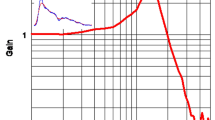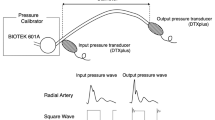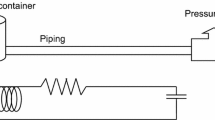Abstract
Objects. The dam** coefficient and natural frequency are standard parameters for clinicians to evaluate the dynamic responses of pressure monitoring lines. But in fact, we had experienced some cases in which there were discrepancies between these parameters and frequency response curves. We tried to elucidate the defectiveness of the dum** coefficient and natural frequency with our new catheter calibration methods. Methods and results. At first we made a laboratory study with a function signal generator, a pressure wave converter, two pressure amplifiers and a personal computer. Using with our high-precision frequency response measurement method (step-response analysis) we clearly demonstrated the defectiveness of these parameters. Additionally a more sophisticated original method (clinical impulse response analysis) was also demonstrated in clinical recommendation, which makes it possible to measure true frequency response characteristics (system transfer function) without a function signal generator and a pressure wave converter, even in the operating room just after priming of the monitoring circuit without contamination. Conclusion. We recommend a clinical impulse response analysis for catheter calibration, instead of dum** coefficient and natural frequency.
Similar content being viewed by others
References
Gardner RM. Direct blood pressure measurement – dynamic response requirements. Anesthesiology 1981; 54: 227–236.
Manoliu V. Modeling of transient response for catheter-pressure sensor system. Abstracts of ATEE (Advanced Topics in Electrical Engineering) 2000. See http://www.iem.pub.ro/ro/evenimente/ATEE-2000/Manoliu.htm
Billiet E, Colardyn F. Pressure measurement evaluation and accuracy validation: the Gabarith test. Intensive Care Med 1998; 24: 1323–1326.
Cheatham ML. Hemodynamic monitoring: dynamic response artifacts. 2002 surgicalcriticalcare.net, See http://www.surgicalcrit-icalcare.net/Lectures/dynamic_response.pdf.
Geddes LA. The direct and indirect measurement of blood pressure. Year Book Medical Publishers; 1970: 46–69.
Geddes LA, Bourland JD. Technical note: Estimation of the dum** coefficient of fluid-filled, catheter-transducer pressure-measuring systems. Journal of Clinical Engineering; 1988: 59–62.
Author information
Authors and Affiliations
Corresponding author
Rights and permissions
About this article
Cite this article
Watanabe, H., Yagi, SI. & Namiki, A. Recommendation of a Clinical Impulse Response Analysis for Catheter Calibration-Dum** Coefficient and Natural Frequency are Incomplete Parameters for Clinical Evaluation. J Clin Monit Comput 20, 37–42 (2006). https://doi.org/10.1007/s10877-005-9008-6
Received:
Accepted:
Published:
Issue Date:
DOI: https://doi.org/10.1007/s10877-005-9008-6




